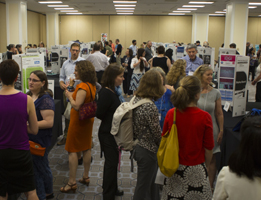EarthX is a design-based research project that supports the integration of Earth science into high school biology, chemistry, and physics courses in Baltimore City Public Schools, while also supporting the district’s transition to three-dimensional (3D), ambitious and equitable science teaching aligned with the Next Generation Science Standards (NGSS). EarthX builds on the success of the Integrating Chemistry and Earth Science (ICE) DRK-12 project, which developed innovative chemistry course curriculum materials and PD strategies, to support Earth science integration into biology and physics course curriculum development and 3D teaching. EarthX will develop, test, and refine embedded and unit assessments for all three courses, along with providing an online system for assessment administration; real-time reporting to teachers and students; and provision of data to PD leaders, administrators, and researchers for multiple purposes. Assessments will be 3D, featuring core concepts from both Earth science and the course discipline combined with a science or engineering practice and a crosscutting concept.
Projects
This project will develop a standards-aligned engineering professional learning model for elementary teachers of multilingual learners. This interdisciplinary approach is innovative in its effort to provide teachers with sustained time to reflect on what they believe about language, their teaching of linguistically and racially minoritized students, and their interactions with multilingual students around engineering content. Using a participatory and collaborative approach, experts in literacy, language, and engineering will work with elementary teachers to develop strategies for how teachers can view students’ multilingualism as an asset to engineering.
The goal of this project is to study how secondary students come to understand better an underlying logic of natural sciences—the relation between construction of new ideas and critique of them. Science education has traditionally focused mostly on how students construct models of natural phenomena. However, critique is crucial for iterative refinement of models because in professional science, peer critique of explanatory models motivates and guides progress toward better understanding. This project engages students in this process and helps them understand the relation of critique to better explanations, by focusing students on the criteria by which critique and understanding develop together through classroom discussions.
This project builds capacity for middle school teachers to enact and adapt integrated STEM curriculum units with their students. The units will focus on biomimicry—examining structures and functions found in nature and applying these to solve human problems, which combines science, engineering, and technology. The project enables teachers to design activities that are personally authentic to their students by supporting teachers to examine their students' assets, needs, and interests and center these during unit design.
The goal of this project is to study how secondary students come to understand better an underlying logic of natural sciences—the relation between construction of new ideas and critique of them. Science education has traditionally focused mostly on how students construct models of natural phenomena. However, critique is crucial for iterative refinement of models because in professional science, peer critique of explanatory models motivates and guides progress toward better understanding. This project engages students in this process and helps them understand the relation of critique to better explanations, by focusing students on the criteria by which critique and understanding develop together through classroom discussions.
This project seeks to better understand how teachers' capacity and willingness to customize instructional approaches to meet standards and the needs of diverse student populations develops through initial practice and successive enactments of curriculum materials. This work will address current gaps in the literature and contribute to an overall understanding of how teachers develop the capacity to use curricula in ways that advance the goal of equitable science instruction.
Scientific argumentation is one of the eight essential practices in the Next Generation Science Standards. Over the past decade, various methods have been employed to help middle-school students develop argumentation skills in formal learning environments. Despite these efforts, teachers continue to face challenges in motivating and engaging students, particularly in addressing the increasingly varied needs of students. Additionally, districts and schools struggle to integrate these research-based methods into their curriculum in ways that gain buy-in from teachers, students, and stakeholders. To address these challenges, this partnership development project brings together the West Aurora School District in Illinois and Northern Illinois University to pursue two primary goals: (1) co-construct a research and development plan focusing on ways to enhance support and effectiveness in the teaching practice of scientific argumentation through technology, and (2) develop a model for building a design research partnership between a school district and a mid-size public university.
